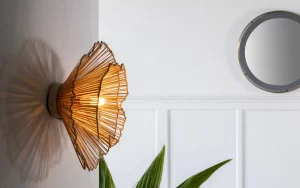
Enchanting Illumination: The Charm of Ceiling Lights
Ceiling lights are an essential part of home decor. They provide both functional and aesthetic benefits, illuminating a room while also adding style and ambiance. Ceiling lights are fixtures that are mounted on the ceiling and provide general lighting for a space. They come in various shapes, sizes, and designs to suit different preferences and interior styles.
Ceiling lights play a crucial role in home decor as they can completely transform the look and feel of a room. They provide the primary source of light in a space, ensuring that it is well-lit and functional. Additionally, they can enhance the overall aesthetic appeal of a room, serving as decorative elements that add character and style.dalsahome
There are several types of ceiling lights available on the market. Some common types include chandeliers, pendant lights, flush mount lights, recessed lights, and track lighting. Each type has its own unique design and functionality, allowing homeowners to choose the one that best suits their needs and preferences.
The Evolution of Ceiling Light Designs: From Traditional to Modern
The history of ceiling lights dates back centuries. In ancient times, people used candles or oil lamps to light up their homes. As technology advanced, so did the design and functionality of ceiling lights.
Traditional ceiling light designs are often characterized by ornate details and intricate craftsmanship. Chandeliers, for example, were popular during the Renaissance period and featured multiple arms with candle holders. These grand fixtures were often found in palaces and mansions.
In contrast, modern ceiling light designs are sleek, minimalist, and often incorporate innovative materials and technologies. Pendant lights with clean lines and geometric shapes are popular choices for contemporary interiors. LED technology has also revolutionized ceiling light designs, allowing for energy-efficient options that can be customized in terms of color temperature and brightness.
Choosing the Right Ceiling Lights for Your Home: A Guide
When choosing ceiling lights for your home, there are several factors to consider. First and foremost, you need to determine the purpose of the lighting. Do you need bright, task lighting for a specific area, or are you looking for ambient lighting to create a cozy atmosphere?
It is also important to consider the size and height of the room. Larger rooms may require multiple ceiling lights or larger fixtures to adequately illuminate the space. On the other hand, smaller rooms may benefit from smaller, more compact fixtures.
Another factor to consider is the style and decor of the room. Ceiling lights should complement the overall aesthetic of the space. For example, a modern, minimalist room may benefit from a sleek pendant light, while a traditional room may be better suited for a chandelier.
Popular ceiling light styles include industrial, farmhouse, mid-century modern, and contemporary. Industrial-style ceiling lights often feature exposed bulbs and metal accents, while farmhouse-style lights have a rustic and charming appeal. Mid-century modern lights are characterized by clean lines and retro-inspired designs, while contemporary lights are sleek and minimalist.
Enhancing Your Home’s Ambiance with Ceiling Lights
Lighting plays a crucial role in creating ambiance in a home. The right lighting can completely transform the mood and atmosphere of a room, making it feel warm and inviting or cool and energizing.
Ceiling lights can enhance ambiance in several ways. First, they provide general lighting that illuminates the entire space. This ensures that the room is well-lit and functional. However, it is important to consider the color temperature of the light bulbs used in ceiling lights. Warm white or soft white bulbs create a cozy and inviting ambiance, while cool white bulbs create a more energizing atmosphere.
In addition to providing general lighting, ceiling lights can also be used to create focal points or highlight specific areas in a room. For example, pendant lights can be used to draw attention to a dining table or kitchen island. This not only adds visual interest but also creates a sense of intimacy and coziness.
To enhance ambiance with ceiling lights, consider layering different types of lighting. Combine ceiling lights with floor lamps, table lamps, and wall sconces to create a well-balanced and dynamic lighting scheme. This allows for flexibility in terms of brightness and creates a more visually appealing space.
The Benefits of LED Ceiling Lights: Energy Efficiency and Longevity
LED ceiling lights have become increasingly popular in recent years due to their numerous benefits. LED stands for Light Emitting Diode, and these lights use a semiconductor to produce light. Compared to traditional incandescent or fluorescent bulbs, LED lights are much more energy-efficient and have a longer lifespan.
One of the main advantages of LED ceiling lights is their energy efficiency. LED lights consume significantly less energy than traditional bulbs, resulting in lower electricity bills. They also produce less heat, making them safer to use and reducing the load on air conditioning systems.
LED lights also have a much longer lifespan compared to traditional bulbs. While incandescent bulbs typically last around 1,000 hours and fluorescent bulbs last around 10,000 hours, LED lights can last up to 50,000 hours or more. This means that LED ceiling lights require less frequent replacement, saving both time and money in the long run.
Furthermore, LED lights are available in a wide range of color temperatures, allowing homeowners to customize the ambiance of their space. Warm white LEDs create a cozy and inviting atmosphere, while cool white LEDs create a more energizing and modern feel.
Ceiling Lights for Every Room: Living Room, Bedroom, Kitchen, and More

Different rooms in a home have different lighting needs, and choosing the right ceiling lights for each room is essential to create a well-lit and visually appealing space.
In the living room, it is important to have a combination of general lighting and task lighting. A central ceiling light fixture, such as a chandelier or pendant light, can provide general lighting for the entire room. Additionally, floor lamps and table lamps can be used to create task lighting for reading or other activities.
In the bedroom, ceiling lights should create a relaxing and cozy atmosphere. Soft, warm white bulbs are ideal for creating a calming ambiance. Pendant lights or flush mount lights with dimmable features are popular choices for bedrooms.
The kitchen requires bright, task lighting to ensure that the space is well-lit for cooking and food preparation. Recessed lights or track lighting can provide ample illumination for the entire kitchen. Pendant lights can also be used to create focused lighting over a kitchen island or dining area.
Other rooms, such as the bathroom, home office, and dining room, also have specific lighting needs. In the bathroom, vanity lights are essential for grooming tasks. In a home office, task lighting is important to reduce eye strain. In the dining room, a chandelier or pendant light can create a focal point and set the mood for meals.
Creative Ways to Use Ceiling Lights in Your Home Decor
Ceiling lights can be used in creative and unconventional ways to add visual interest and enhance the overall decor of a space.
One creative way to use ceiling lights is by installing them in unexpected places. For example, instead of using traditional table lamps on bedside tables, pendant lights can be hung from the ceiling on either side of the bed. This not only frees up space on the bedside tables but also creates a unique and stylish look.
Ceiling lights can also be used as decorative elements in themselves. Chandeliers with intricate designs and crystal accents can serve as statement pieces in a room. Pendant lights with unique shapes or materials can add a touch of personality to a space.
Another creative way to use ceiling lights is by creating patterns or designs with multiple fixtures. For example, in a hallway or entryway, multiple pendant lights can be hung at different heights to create a visually striking installation. This adds visual interest and creates a sense of drama.
Ceiling Lights as Statement Pieces: Unique and Eye-Catching Designs
Ceiling lights can serve as statement pieces in a room, adding a touch of drama and personality to the space. Unique and eye-catching designs can become the focal point of a room and create a lasting impression.
When choosing statement ceiling lights, it is important to consider the overall style and decor of the room. The light fixture should complement the existing elements and enhance the overall aesthetic appeal. For example, in a modern, minimalist room, a sleek and sculptural pendant light can make a bold statement. In a traditional room, a grand chandelier with ornate details can add elegance and sophistication.
There are countless unique and eye-catching ceiling light designs available on the market. From geometric shapes to unconventional materials, homeowners have a wide range of options to choose from. Some examples include bubble chandeliers, industrial-style cage pendants, and sculptural LED fixtures.
DIY Ceiling Light Projects: Personalizing Your Home Lighting
DIY ceiling light projects offer homeowners the opportunity to personalize their home lighting and create unique fixtures that reflect their personal style.
One of the main benefits of DIY ceiling light projects is the ability to customize the design and materials used. Homeowners can choose their own materials, such as reclaimed wood or metal, to create a one-of-a-kind fixture. They can also experiment with different shapes and sizes to create a truly unique piece.
There are numerous DIY ceiling light project ideas available online for inspiration. Some popular ideas include creating a pendant light using mason jars or repurposing old wine bottles into hanging lights. These projects not only allow homeowners to personalize their lighting but also provide an opportunity for upcycling and reducing waste.
When embarking on a DIY ceiling light project, it is important to ensure safety and follow proper electrical wiring guidelines. If you are not comfortable with electrical work, it is recommended to consult a professional to ensure that the fixture is installed correctly and safely.
Maintenance and Care of Ceiling Lights: Keeping Them in Top Condition
Proper maintenance and care of ceiling lights are essential to keep them in top condition and ensure their longevity.
Regular cleaning is important to remove dust and dirt that can accumulate on the fixtures. To clean ceiling lights, first, turn off the power to the fixture. Then, carefully remove any glass or plastic components and clean them with a mild detergent and water. Use a soft cloth or sponge to gently wipe down the rest of the fixture. Avoid using abrasive cleaners or scrub brushes as they can damage the finish.
In addition to regular cleaning, it is important to check the bulbs regularly and replace them as needed. Burnt-out bulbs can affect the overall lighting quality and reduce the lifespan of the fixture. LED bulbs typically have a longer lifespan compared to traditional bulbs but should still be checked periodically.
It is also important to inspect the wiring and connections of ceiling lights regularly. Loose or damaged wiring can be a safety hazard and should be addressed immediately. If you notice any issues with the wiring or connections, it is recommended to consult a professional electrician for repairs.
Ceiling lights are an essential part of home decor, providing both functional lighting and aesthetic appeal. From traditional chandeliers to modern pendant lights, there are countless options available to suit different preferences and interior styles. When choosing ceiling lights for your home, consider factors such as the purpose of the lighting, the size and height of the room, and the overall style and decor. Ceiling lights can enhance ambiance, create focal points, and serve as statement pieces in a room. LED ceiling lights offer energy efficiency and longevity, making them a popular choice for homeowners. Different rooms in a home have different lighting needs, and it is important to choose the right ceiling lights for each space. Creative ways to use ceiling lights include installing them in unexpected places or using them as decorative elements. Statement ceiling lights can add drama and personality to a room, while DIY projects allow homeowners to personalize their lighting. Proper maintenance and care of ceiling lights are essential to keep them in top condition and ensure their longevity. By considering all these factors, homeowners can choose the right ceiling lights for their home and create a well-lit and visually appealing space.


